How to have a totally immersive Indigenous holiday
Waves froth around Trent Bundirrik Lee’s ankles as he bends to scoop a handful of water, splashing it across his arms while singing out to his ancestors; a saltwater ceremony as old as time itself.
We are invited to follow, our sweat mixing with the sea, connecting us with Larrakia elders and letting them know we are here.
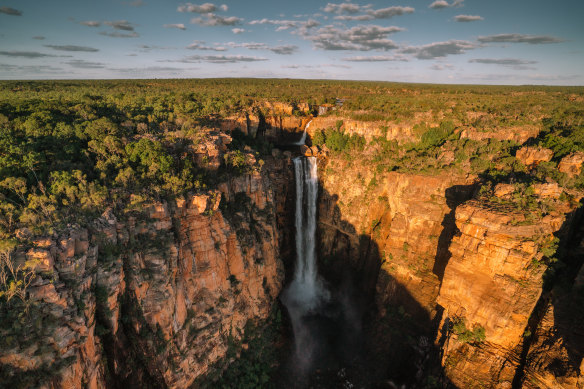
Jim Jim Falls, Kakadu.
“Country needs to smell and taste you,” says Lee, owner of Saltwater Cultural Tours Darwin. “To keep you safe and to remember your energy the next time you visit.”
The sun is low on Casuarina Beach, its luminous surface twinkling like a thousand shooting stars. As we splash, Lee shares stories about Daribah Nungalinya, a rock shelf visible only at low tide.
Known as Old Man Rock it sits quietly in the distance, a sacred site and integral part of the Larrakia creation story. “As a custodian of this land it is my purpose to take care of our Saltwater country,” says Lee.
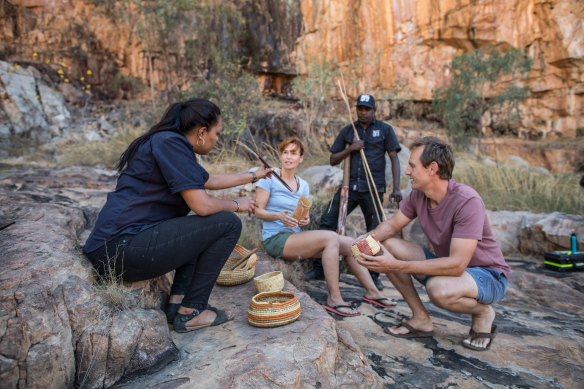
Immersed in Top End cultural tours.
Australia’s Aboriginal and Torres Strait Islander people have been caring for Country for at least 65,000 years, maintaining rich and diverse cultures through storytelling, song, dance, language and lore. Traditions that are still dynamic and in practice today.
Yet, in the everyday, predominantly urban lives of most non-Indigenous Australians, there are few opportunities to make cultural interactions.
Some people hold back, concerned they’ll cause offence by asking the wrong questions; others are willing, but lack awareness about the diversity of Indigenous tours on offer. Some simply don’t know where to start.
But the rise in new and expanded Indigenous-owned tourism ventures across the Top End of Australia is helping to change this.
While Lee takes visitors to Casuarina Beach to learn skills such as fire-making and spear-throwing, others are running language workshops inside contemporary art galleries or creating unique dining experiences based on native ingredients.
All are strengthening ties to their country, creating employment and bridging cultural divides with visitors.
This year - as Australians are due to head to a referendum to vote on giving First Nations people a direct say on the laws and policies that affect them, by constituting an Indigenous Voice to Parliament - what better and more appropriate time could there be to incorporate an Indigenous experience into your next holiday.
As a descendant of the Awabakal people from the Mid-North Coast of NSW I’m still on my own journey towards uncovering my heritage.
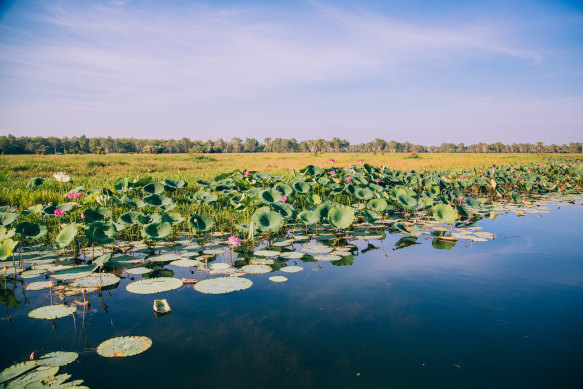
Yellow Water, Kakadu.Credit: Tourism Australia
With these thoughts firmly in mind, I’m setting off on a 10-day, fully Indigenous tourism-focused trip, crossing dozens of countries from Darwin, to the Tiwi Islands, Litchfield, Kakadu, Katherine and Nitmiluk Gorge. I have much to learn and discover over the next week and a half in these parts.
Of course, you don’t need to have to such background to replicate my journey below or in fact any of its equivalents around the nation.
DAYS ONE TO TWO:
Lingering with the lingo - Darwin and surrounds
I’m staying in a one-bedroom apartment at the partly Indigenous-owned Adina Apartment Hotel Darwin Waterfront. The location makes an ideal base for exploring this tropical city, but more importantly, I’m drawn to the hotel’s commitment to making a real difference in the lives of Indigenous Australians.
While the local artwork in the foyer – including the giant mural Gwarriyagwa, 2023 (Long ago) by Trent Lee – is a delight, it’s the noticeable staff ratio of 38 per cent First Nations people (and growing), which sets this hotel apart.
I meet Larrakia elder Aunty Bilawara Lee, in the hotel’s Curve cafe. As an ambassador for the hotel, she is involved in recruiting and mentoring new staff and conducting Welcome to Country ceremonies.
She also performs regular smoking ceremonies to keep everyone well. But her ultimate mission is to help resurrect the Larrakia language.
“It is our connection to our country, to our ancestors,” she says. “I want our language to once again be a living energy.”
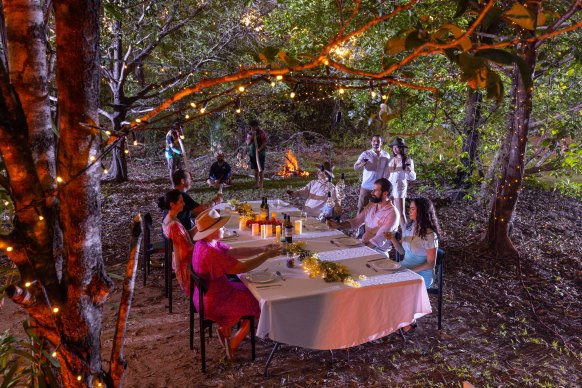
Kakadu Full Moon Feast at Cooinda.Credit: Kakadu Tourism
In Darwin’s creative neighbourhood of Parap Village, Nina Fitzgerald is on a similar quest - but with a modern twist.
As one of Darwin’s leading creatives – championing Indigenous art and fashion on a national scale – Fitzgerald, whose family comes from Kakadu, the Torres Strait Islands and the Wuthathi people, co-founded Laundry Gallery in July 2022.
With the tagline “Old stories, new spin”, the multidisciplinary hub is housed in a repurposed ’70s-era laundromat.
“The space is a pathway for sharing age-old stories, while showcasing where Indigenous cultures sit in a contemporary world,” says Fitzgerald, showing me a collection of traditional dilly bags, which have been woven from discarded ghost nets.
I’m here for a language workshop with women from the Bininj Kunwok Regional Language Centre. Sitting cross-legged on the woven mat we are invited to introduce ourselves in Kunwinjku, a dialect from western Arnhem Land. “Ngaye ngangeyyo – my name is – Kerry,” I reply.
And with that one phrase I am now part of an effort to keep an endangered language alive. How often do you get to say that?
DAY THREE
Like no place on Earth - Tiwi Islands
From the air, Apsley Strait is a ribbon of turquoise separating the tufted green of Bathurst and Melville Islands. Venous rivers pulse against bone-white beaches, their scalloped edges outlined by ochre cliffs, while mirrored lakes reflect the sky and all its celestial stories.
Eighty kilometres north of Darwin, where the Arafura Sea joins the Timor Sea, these two tropical islands are like no place on Earth. Isolated from continental Australia when sea levels rose about 8000 years ago, the Tiwi people developed a unique culture that is totally different to the mainland.
I’ve visited before -arriving either by yacht or Sealink ferry – but today an eight-seater charter flight from Darwin crosses thousands of years in under 30 minutes.
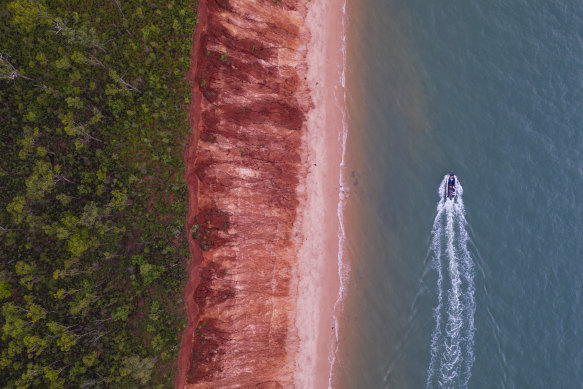
Pink shores of Melville Island, Tiwi Islands.
Tiwi elder Edward (Teddy) Portaminni meets our group of four at Bathurst Island’s tiny airport. Together with his wife Tereresia, they run Tarntipi Bush Camp, a home-stay where visitors spend time with family on country while participating in traditional activities.
As the only Tiwi-owned and operated accommodation on the island, Teddy’s vision is to build Tiwi self-determination, while creating true dialogue and understanding with visitors.
It’s late in the wet season and access to the bush camp is still restricted, so I’ve opted for a tailored tour of the main township Wurrumiyanga. With Teddy as our guide, not only do we visit art centres such as Bima Wear, Ngaruwanajirri and Tiwi Design but gain rare insights into a rich culture where art and kinship are intricately tied.
We learn about Pukumani (burial) poles, about the skin groups and totem dances bestowed at birth, and the three religions on the islands - Tiwi, Catholic and Aussie Rules football.
We end with a fishing lesson on the beach of Apsley Strait, where Teddy continues to share his vision for Tarntipi. “I also want the camp to be a place where Tiwi themselves can come to learn,” he says. “Where I can pass on my cultural knowledge, teach the young ones about bush medicine. Grow them strong.”
It’s humbling to spend time with such a generous and wise elder, bearing witness to what is at stake and why an enshrined Indigenous Voice to Parliament is the only way forward.
DAY FOUR
From frontier wars to stolen lives - Darwin to Litchfield National Park
A day-tour to Litchfield National Park with Tess Atie from Northern Territory Indigenous Tours delivers waterfalls, stunning scenery, and a wallop of hard truths.
“See this country, it’s empty of people,” says Atie, her arm sweeping the pastoral lands on the outskirts of the park. “Our people had to flee their homelands. It started with the killings, like the Daly River massacre in 1884. Then they took the children.”
Frontier wars, the Stolen Generation, incarceration of Aboriginal children. No topic is off limits with Atie, during her Indigenous Litchfield Spectacular tour.
A Marrathiel woman, with family connections from Mandorah to Daly River, Atie established her tour company in 2009 to showcase her family’s traditional country. “I want the penny to drop. People need to know the harsh reality of our past, because we are still affected by it today.”
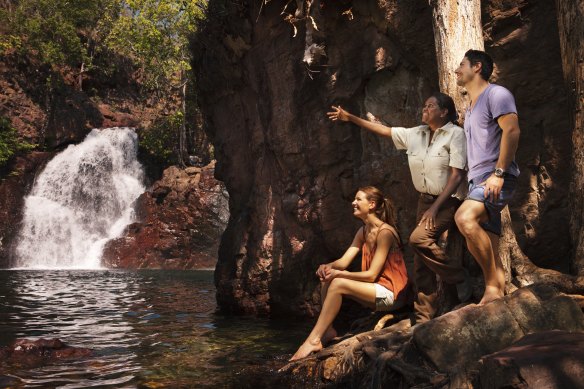
Litchfield National Park.Credit: Tourism Australia
Over the course of the day, we walk through stone country to Tolmer Falls, hike alongside clear creeks and enjoy a lunch of freshly barbecued barramundi.
At Wangi Falls, water tumbles over a cleft in the rock, throwing up clouds of mist and creating twin arcs of rainbows.
“This is a very sacred place for women. My aunties would bring us girls here for ceremony when we turned into young women,” says Atie, introducing me to the land as if it were a living person.
“It hurts me to see people swimming here. To see it being used as a playground.” Atie prefers to take guests for a swim away from the crowds at Walker Creek or Woolaning Spring on a private section of her family’s land.
For those wanting to go deeper with their learning, Atie has just started women-only tours, taking guests out on country to fish, hunt for long-necked turtles, and dig for yams and mud crabs.
DAYS FIVE TO SEVEN
Where stories were waypoints - Kakadu National Park
The three-hour drive from Darwin to Kakadu crosses many nations; from Larrakia country, through the homelands of the Limilngan-Wulna and finally to the land of the Bininj/Mungguy people. I’ve hired a four-wheel-drive and nicknamed her the Beast.
“That’s Lightning Dreaming,” says James Morgan, Bininj man and founder of Yibekka Kakadu Tours, pointing to three hulking rock pillars seemingly carved into the distant Arnhem Land escarpment. “It’s where Narmarrgon - Lightning Man - lives. It is a dangerous sacred place.”
I’m with Morgan for a sunset tour of the Burrungkuy (Nourlangie) rock art site, a place of rich cultural significance. “For us Bininj people, we see the stories that are written in the landscape,” he says. “We didn’t have maps, so the stories were our waypoints.”
After a day exploring the park, the Indigenous-owned Cooinda Lodge Kakadu is a welcome haven, situated in the heart of Kakadu next to Yellow Water Billabong.
I’m staying in a motel-style Lodge Room, which has an ensuite bathroom and private verandah. Other options include tent-style Outback Retreats, with shared amenities, and five brand-new, luxurious Yellow Water Villas.
Cooinda is also home to the Kakadu Full Moon Feast, a dining experience held on the rising full moon (selected dates May to November) featuring locally foraged Indigenous foods paired with non-alcoholic beverages.
A collaboration between Ben Tyler, a Bininj man and founder of Kakadu Kitchen, and Cooinda Lodge Executive Chef Phil Foot, the four-course menu changes in line with the shifts in Kakadu’s six seasons.
“We are trying to capture the essence of 65,000 years of culture and put it on a plate,” says Tyler. “Mainstream interest in traditional food is helping to move conversations about Aboriginal philosophy along. It’s also a way we can reconnect with country.”
From Cooinda it’s a 40-minute drive to Marrawuddi Arts and Culture, a community art centre and gallery which is owned and governed by the Mirrar traditional owners. Engaging over 500 artists from Kakadu and the wider region, the centre moved to its new site in the repurposed Jabiru Bakery in October 2020.
As Jabiru transitions from a former uranium mining town to a cultural hub, Marrawuddi Arts and Culture is flying the flag for the town’s future based on Aboriginal-led sustainable tourism.
“Indigenous self-determination is more important now than ever,” says Katie Hagebols, art centre manager.
DAYS EIGHT TO 10
Echoes of love, loss and longing - Katherine and Nitmiluk Gorge
It’s a nearly three-hour drive from Kakadu to Katherine, the time passing easily with Yolŋu Radio 88.9FM playing a mix of Aboriginal rock/reggae and traditional tunes.
Driving south I cross from the land of the Bininj to the Jawoyn people, but it’s inside the gallery of Top Didj Cultural Experience and Art Gallery that I get a clear picture of the region’s language groups.
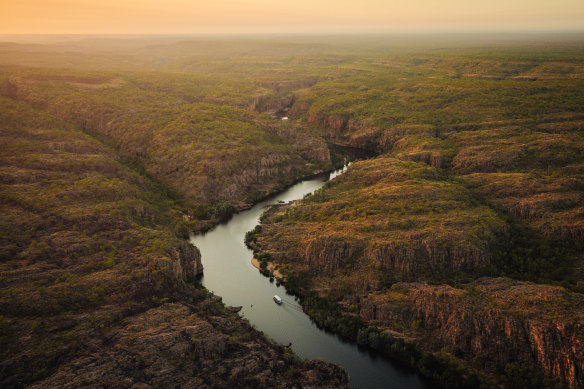
Spectacular views of Nitmiluk Gorge.
“I got my totems, my dance and my language from my dad,” says Manuel Pamkal, pointing to Dalabon land on a hand-painted wall mural, his face lit with love and memory. “I got my skin name – Godjok – from my mother.”
Pamkal is an artist, NAIDOC elder of the year (2022) and senior cultural guide at Top Didj. He’s also a TikTok sensation with 317,500 followers and more than 5 million likes. “During the COVID mess I had to find another way to share my story, share my culture, keep it strong,” he says. “And through TikTok I can take it to the world.”
I join Pamkal for a two-hour cultural experience, which includes learning the technique of rarrk painting (cross-hatch) using a traditional reed brush.
While we paint, he shares stories; about growing up in a community, so remote he has no idea if he was born in 1966 or 1963; about his concerns for young kids who are disconnected from culture; and about quitting alcohol after his years of living rough as a “long-grass man”.
Throughout, he teaches us some words in Dalabon, a central Arnhem Land language spoken fluently by less than 30 people. Leaning in, I hear echoes of love and loss and longing, for a time when the land and language were one.
At Nitmiluk National Park, my education continues as I cruise a section of Nitmiluk (Katherine) Gorge, where crumbling cliffs of red rock soar above our heads and Bolung, the Dreamtime Rainbow Serpent, still resides.
In 1989 the 292,008-hectare national park was handed back to the Traditional Owners, the Jawoyn people, in recognition of their spiritual connection to the land.
While the park is jointly managed with the Parks and Wildlife Commission of the Northern Territory, all activities, tours, visitor centre, campground and high-end Cicada Lodge are exclusively owned and operated by Jawoyn Association-owned Nitmiluk Tours.
Cicada Lodge is a showpiece, perched above the gorge, its 18 free-standing rooms with private balconies overlook quiet bushland.
There’s a swimming pool, indoor-outdoor dining (paperbark smoked eye-fillet for the win) and enough Jawoyn-led activities to keep you busy for days. Make sure you are back by sunset for the complimentary drinks and canapes, served each evening as the fruit bats darken the sky.
It’s a fitting end to my journey, to see tourism and culture flourishing under Jawoyn stewardship; where profits go to supporting health, employment and training, where a council of elders continue to build culture and community, and where caring for, and sharing country lies at the heart of every endeavour.
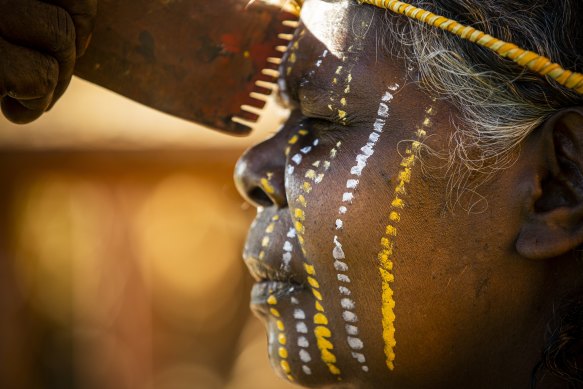
Immersive and unforgettable.
On my final morning I meet the Jawoyn Association and Banatjarl Women’s Group as they set up their new gift shop in the visitor centre.
While the young ones lay out tubs of bush medicine and hand-woven earrings, I sit with the elders.
At this moment, I feel one step closer to understanding the complexities of an Indigenous way of life that has sustained this land since time immemorial. A way of life that needs to be heard, respected and empowered.
CULTURAL PROTOCOLS: WHAT YOU NEED TO KNOW
Journeys
Travelling through some Aboriginal and Torres Strait Islander communities requires a permit. Apply online through the Northern Land Council (nlc.org.au)
Signage
Check with your guide or observe signage in regard to taking photographs, as some sites are of high cultural significance and photography/entry is forbidden.
Attire
Dress codes for visitors vary between communities, but modest clothing will always be appreciated.
Art
Ensure you buy Indigenous art ethically by doing your research, asking questions and reading the Indigenous Art Code. Authenticity issues still exist, as seen by the recent allegations of white interference of First Nations artwork. See indigenousartcode.org
Storytelling
In traditional culture, listening to the storyteller is vital to ensure accuracy. For this reason, it is best to make few interruptions when your guide is speaking.
THE DETAILS
FLY
Qantas operates regular services to Darwin from Sydney and Melbourne and other capitals. See qantas.com
STAY
Adina Apartment Hotel Darwin Waterfront offers studio, one- and two-bedroom apartments. Prices for a premier studio from $231 a night. See adinahotels.com
Cooinda Lodge Kakadu offers superior Lodge Rooms, which include one queen bed and one single, from $199 a night. See kakadutourism.com
Cicada Lodge offers rooms from $491 a night including a welcome beverage on arrival, sunset drinks, evening canapes and continental breakfast for two. See cicadalodge.com.au
SEE + DO
Saltwater Cultural Tours, saltwaterculturaltours.info; Laundry Gallery, laundrygallery.com.au; Tarntipi Bush Camp, see tarntipi.com; Northern Territory Indigenous Tours, see ntitours.com.au; Yibekka Kakadu Tours, see yibekka.com.au; Kakadu Full Moon Feast, see kakadutourism.com; Marrawuddi Arts and Culture, see marrawuddi.com.au; Top Didj Cultural Experience and Art Gallery, see topdidj.com; Nitmiluk Tours, see nitmiluktours.com.au
MORE
Kerry van der Jagt was a guest of Tourism NT
Sign up for the Traveller Deals newsletter
Get exclusive travel deals delivered straight to your inbox. Sign up now.